Lighting Homes in Cahess
Home Lighting Initiative (From the September CHM Newsletter)
By Ken Johansson
It was during my 7th trip to Haiti, that I realized how dark rural Haiti is at night. I did not normally leave the North Haiti Mission compound at night. The buildings on the compound had electric lights. These lights were powered by a gasoline generator.
One night, several of my local Haitian brothers took me to a Haitian Pharmacy. On the return trip it was extremely dark, and I fell into a roadside ditch. Did that hurt, and I can still remember the pain. That was my wake-up experience, as to how dark it is in a country with minimum lighting. It was particularly graphic to me as a resident of the United States, where good lighting is taken for granted.
It was during that trip that I also realized that Haitian homes were also extremely dark. That was the beginning of my quest to provide lighting for Haitian homes. Those efforts have had some temporary successes, and next month I will detail some of our lighting history.
Suffice it to say, that the need for household lighting that is safe and yet affordable, is still very great.
Cahess is located on a road between the towns of Trou du Nord and Caracol. There is an electrical power grid along this road, originating in Caracol where a new factory was built, which included an electric power generation station. The problem is that many of the homes are far from the road, and therefore wiring to these homes is cost-prohibitive.
So, the lighting problem remains for approximately 70% of the homes in Cahess, according to a quick initial survey.
The typical way that these 70% of homes provide light, is to use open flame kerosene lamps. This lighting is very dim, and the health hazards created by the burning kerosene is extremely bad for humans.
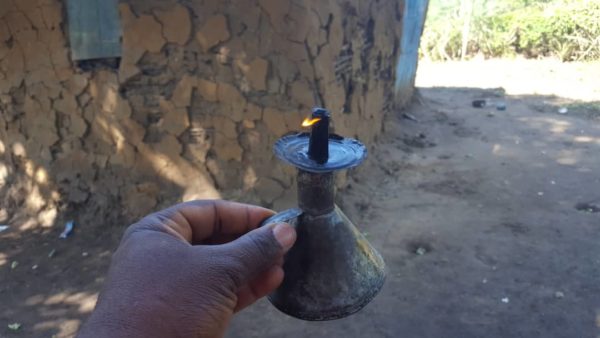 A typical kerosene lamp used for light in Haitian homes.
A typical kerosene lamp used for light in Haitian homes.
It is estimated that using one of these lamps for a night in a home, is equivalent to smoking one pack of cigarettes. To correct this problem, we will try to come up with affordable lighting that is both good and safe.
Next month, we will detail some of our past efforts that have been used over the ensuing years, since the year 2000.
During the month of October 2020, we will be conducting a thorough survey of the lighting in the Village of Cahess. We want to verify that the problem we aim to solve, actually exists. Next month, we will present the results of our survey.
Ken Johansson
Home Lighting Initiative
(From the October 2020 CHM Newsletter)
Lighting Survey of Homes in Cahess
There are approximately 254 houses in the Village of Cahess, containing about 400 families.
Of the 254 houses, about 79 have been connected to the electrical grid. However of the 79, about 40 of these houses have been
disconnected from the grid, because the occupants could not pay for the electricity that they were using.
The end result is that approximately 214 of these houses have no connection to the electrical grid.
Further questioning yields the result that most of these 214 homes use the traditional kerosene lamps for lighting purposes.
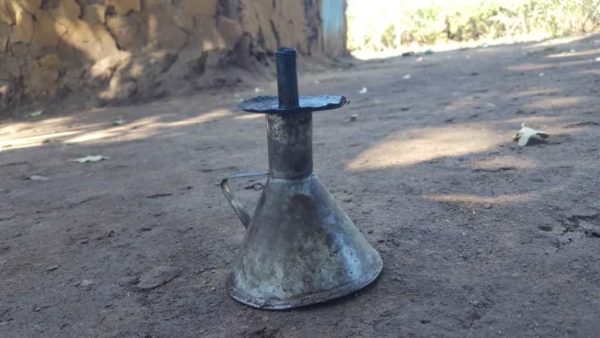
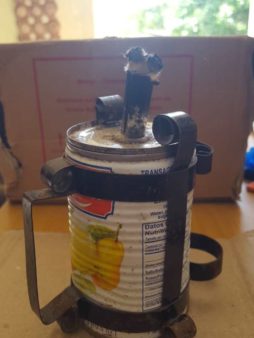
A History of OUR Lighting Efforts in Cahess
There have been three attempts to provide household lighting since 2002. We review each of them below, to gain an understanding on how to proceed in the future.
- The first attempt was to provide whole house light systems using solar panels and supporting electronics. The solar panels and the electronics, had to be hand-carried as luggage, from the United States to Haiti. A small number of systems were installed. The fact that the solar panels were subject to being stolen, and the high cost of each system, ended the program.
2. The next effort was to provide a battery powered reading lamp. This was a very simple design, created by David Stidham.
The lamps were assembled in Haiti, by the Haitian people, using a kit of parts, that we provided, through North Haiti Mission.
A battery charging station, powered by two large solar panels, was designed and installed in the home Amodius Joseph.
When the battery of a table lamp was discharged, the user would then bring the battery to the charging station and exchange it for a charged battery.
This was a free service.
The program ended when the Haitian people decided the reading light did not provide enough light.
Instead of building the reading light from the kit of parts we supplied, the battery was used for other purposes, and the remaining parts were discarded.
3. The third attempt was to provide solar powered handheld lights called BOGO lights. The concept of the name of this light was: Buy One, Give One.
The creator of this light, Mark Bent made heroic attempts to produce this light for the people of third world countries. But in the end, he was unable to continue production.
We were part of North Haiti Mission at the time. We provided one hundred and fifty of these lights during one mission trip.
It turns out that these lights were not able to tolerate continued daily use, in the environment of Cahess. They were a great product, but eventually they failed.
Conclusion
The conclusion we draw from this history is, that all future efforts must factor into the development, the sustainability of the design.
As we develop the next Lighting Systems, we need to make sure that our offerings will be durable, and yet, be able to be upgraded, as technology develops new and better products.
Archives
From the archives, we look back at these projects used to help light up Haitian homes, to help light up our way, to develop good, yet affordable lighting systems for the Haitian people.
The first section includes a video of our first whole house system. The video is NOT of professional quality, but it does convey our story.
It was recorded by one of our wonderful short-term missionaries named Jim McGuy. Jim and his wife Martha loved God and the Haitian people, and they were great mission team members.
The next section is the Table Reading Lamp, designed by David Stidham. My first view of this lamp was on his kitchen table, where he had his daughter Youle read, using this light only.
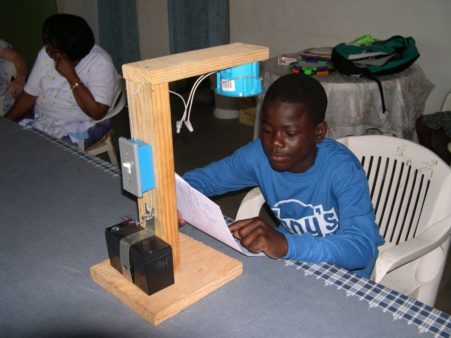 Fadius reading, using the Table lamp
Fadius reading, using the Table lamp
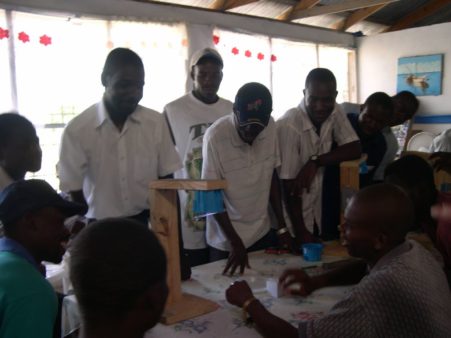 Constructing Table Lamps
Constructing Table Lamps
The final section exhibits the BOGO Light. It was developed and manufactured by SunNight Solar, owned by Mark Bent.
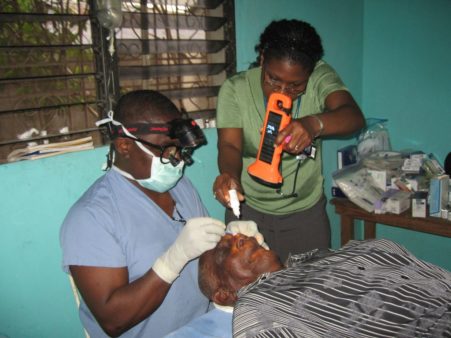 Esther Stidham assisting an eye surgeon with a BoGo Light
Esther Stidham assisting an eye surgeon with a BoGo Light
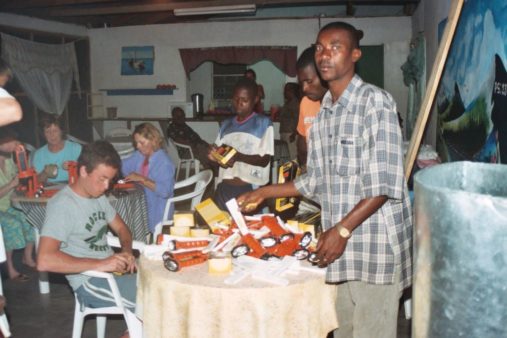
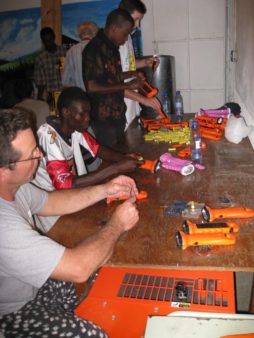 Installing batteries in 150 BoGo Lights
Installing batteries in 150 BoGo Lights
Fixing a Dark Problem in Cahess
The September 2020 CHM Newsletter describes the way most families light their homes at night.
These kerosene lamps create many dangerous conditions.
This list describes some of the negative conditions of using these lamps
- The open flame creates a huge fire risk to the families using this lamp.
- The amount of light is very small, similar to that of a candle.
- This lamp gives off smoke which causes cancer and emphysema.
- The smoke creates a blue haze.
- The smoke creates an oily smell.
- Kerosene must be purchased to fuel this lamp.
 A typical light currently in use in the homes of Cahess.
A typical light currently in use in the homes of Cahess.
Our Solution to Light Holmes in Cahess
Part 1
The first part of the system consists of a bright LED lamp powered by a substantial rechargeable battery. The battery must be rechargeable because the people do not have money to purchase replacement batteries.
The light is a Maxxeon CYCLOPS WorkStar 810. It is available for purchase on the Internet. It can be viewed on the Maxxeon website www.maxxeon.com
This light is an industrial grade product, which is needed for it to survive the hard use it will receive in the rural Haitian environment.
The handle of the light (which is like a yoke), allows the light to rotate in the handle to 12 positions. There is a strong magnet in the handle which allows the light to be easily moved to many locations and still be securely mounted at each position.
The light has 3 switch selectable brightness settings.
The brightest setting will last for 2 hours
The medium brightness setting will last for 4.5 hours
The lowest brightness setting will last for 10 hours.
The amount of light at the lowest setting is a huge improvement over the kerosene lamp. (I am guessing more than several hundred times better).
Additionally, the quality of the light is a major improvement, approaching that of daylight, as compared to the very yellow flame of the kerosene lamp.
The battery of the light can be recharged in 3 hours.
If the electric grid is available, the battery can be charged with a cell phone charger.
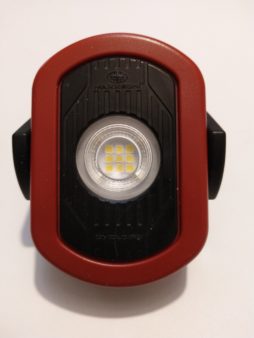 Front View
Front View
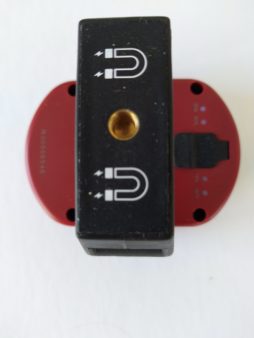 Bracket Top
Bracket Top
 Bracket Side View
Bracket Side View
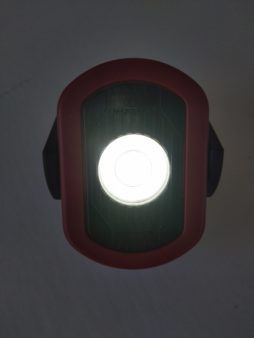 Illuminated Light, Lowest Brightness Setting. It is impossible to adequately demonstrate the light output of this lamp in a photograph. The brightness is so intense.
Illuminated Light, Lowest Brightness Setting. It is impossible to adequately demonstrate the light output of this lamp in a photograph. The brightness is so intense.
Part 2
The second part of the system is needed to recharge the lamp battery when there is no electrical power.
We have found a charity who manufactures a solar powered charging station.
The name of this organization is Unite to Light. This organization is very well established and is committed to providing light to the world’s population that lives with lighting conditions similar to those in Cahess. You can view their website at www.unitetolight.org
This Solar Charger & Battery Bank can, when it is fully charged, charge the internal battery of the light 2 times without being recharged itself. The combination of the Solar Charger and Battery Bank when connected to the light, can be charged simultaneously when in bright sunlight.
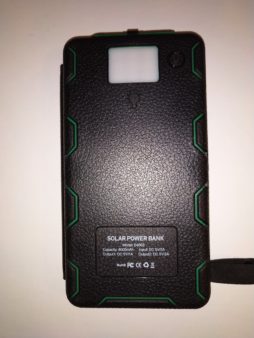 Solar Charger and Battery Bank (Folded Position)
Solar Charger and Battery Bank (Folded Position)
 Solar Charger and Battery Bank
Solar Charger and Battery Bank
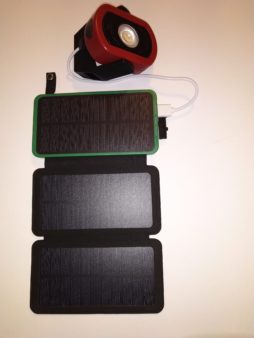 Solar Charger and Battery Bank, Charging the Light
Solar Charger and Battery Bank, Charging the Light
Part 3
Evaluation
The Cyclops light was tested and found to meet or exceed its published specifications. The amount of light on the least bright setting will illuminate a typical room in a Haitian Home, and it can be used at this setting for 10 hours. The 2 higher brightness settings will substantially add more illumination to the typical room, although for a shorter time period, typically 4.5 hours and 2 hours, respectively.
The Solar Charger and Battery Bank, as its name implies, serves both as a charger, and as a charge storage device. It has a large internal battery, which when fully charged, contains enough electrical energy to fully charge the Cyclops light 2 times, before needing to recharge itself.
The Solar Charger and Battery Bank contains electronics to protect itself from overloads. It has 2 output ports and can charge 2 cell phones simultaneously.
We sent a sample system to Pastor Coty to determine the interest level of the residents of Cahess.
Pastor Coty’s reply was that everyone wants a system.
We can fix the dark home problem in the Village of Cahess by providing these systems.
The cost of the Maxxeon Cyclops Light is ——————————-$25.00
The cost of the Unite to Light Solar Charger and Battery Bank is $30.00
Domestic Shipping and International Shipping and Customs —–$25.00
Total cost per lighting system $80.00
This is an estimated cost because we won’t know what shipping and customs will be, until we actually send the first batch of systems.
CHM’s plan is to ship 10 systems, to verify the estimated cost of $800.
CHM is accepting donations of any amount for this project. If you wish to help light up a home in Cahess, please send your donation to the address at the end of this newsletter, and mark your gift “home lighting”; or use our PayPal service also at the end of this newsletter.
Home Lighting Program
We Did It.
Together we have raised the $800 needed to purchase and ship the first 10 home lighting systems to light up homes in the Village of Cahess.
The next step is to purchase the lights and the solar chargers. Upon receipt of these items, they will be packaged and sent to a shipping company in Florida.
Neither the lights nor the solar chargers can be shipped by air freight because of the high energy batteries that are used in each device. Ground shipping within the United States will be used. Shipment to Haiti will be in a shipping company container, on an ocean going ship.
We include the above shipping information, because we cannot predict when these systems will get to Cap Haitien and then to Cahess. We will report the status in the May 2021 CHM Newsletter.